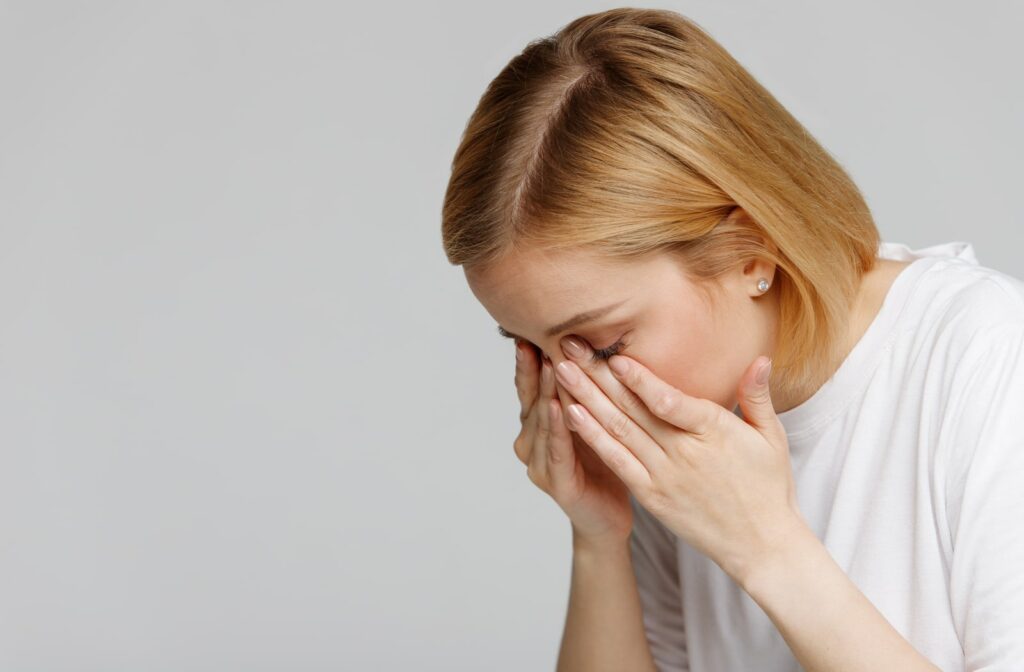Dry eye symptoms can be uncomfortable at best and, at worst, excruciating. Over 11 million Canadians suffer dry eye symptoms, but seeking treatment can be hard when you don’t know what you’re experiencing.
Understanding how dry eye occurs, the symptoms to watch for, and how to prevent dry eye from developing or getting worse is essential for your eye health.
What is Dry Eye?
Lack of tears or poor quality of tears are the most common causes of dry eye. Dry eye can easily set in when tears aren’t produced well enough or evaporate too quickly. It can be immensely uncomfortable and damage the eye surface, potentially leading to vision loss if left untreated. In most cases, symptoms include:
- Intense pain
- Eye redness
- Burning sensation
- Blurry vision
- Watery eyes
Dry eye usually results from the normal aging process, and you should be aware of the increased risk as you grow older. However, dry eye can also be caused by:
- Digital eye strain
- Meibomian gland dysfunction
- Exposure to dry air
- Laser eye surgery
- Certain medications
- Prolonged contact lens use
- Smoking cigarettes
A regular eye exam allows your optometrist to diagnose diseases like dry eye. If you suspect you have dry eye, your doctor will run a couple of tests to confirm your diagnosis. These tests measure tear production, tear quality, and water levels in your tears.
If the tests confirm you have dry eye, your doctor will create a treatment plan to help relieve your discomfort. Your plan could include medication, artificial tears (eye drops), or procedures like intense pulsed light therapy that your optometrist performs in the clinic.
Intense Pulsed Light Therapy Explained
Suppose artificial tears and medication don’t solve your dry eye. In that case, intense pulsed light (IPL) therapy is an option that could bring you relief.
IPL targets one of the root causes of dry eye, using light pulses to release oil build-up in your meibomian glands. During a typical IPL treatment, you can expect:
- Your optometrist will place shields over your eyes
- A cooling gel will go on the skin under your eyes
- Your optometrist will use the IPL device on the skin under your eyes
An IPL treatment session usually takes about 15 minutes. Before your appointment, your optometrist will ask you to avoid excessive sun exposure and refrain from using makeup for 2 weeks.
After an IPL treatment session, you may experience redness, itchiness, skin irritation, and some discoloration. Your optometrist will likely recommend you use SPF-30 or higher sunscreen to protect the skin around your eyes in between sessions. You should also avoid the sun for 2 weeks following treatment.
The number of sessions you need will depend on the severity of your condition. It will typically take around 3 IPL treatment sessions before you notice any relief or difference in your dry eye condition. Your eye doctor will work closely with you to ensure you’re as comfortable as possible throughout your treatment.
The Eye-Light IPL Treatment Difference
Eye-Light offers a different experience from other IPL treatments. It mixes intense pulsed light therapy with low-level light therapy (LLLT) to provide a less physically intense experience.
There’s no need for cooling gel when using Eye-Light because it doesn’t affect the skin as harshly. Another benefit is that it allows treatment of both eyelids simultaneously. Typical IPL treatments require separate treatment for lower and upper eyelids.
Since Eye-Light doesn’t irritate the skin as much as typical IPL therapy, you can typically resume regular activities immediately after treatment, including going out in the sun. In many cases, people treated with Eye-Light after one session have immediately reduced their eye drop usage to manage dry eye.
Tips to Avoid Dry Eye
There are a couple of key ways to reduce your risk of developing dry eye and maintain eye health for longer. For example, you can’t produce tears that keep your eyes lubricated if you’re dehydrated. Your body needs more water than you might expect to stay hydrated, so set a daily water goal to help you stay on track.
You can also avoid dry eye by:
- Avoiding dry air
- Using a humidifier
- Quitting smoking
- Using eye drops
- Reducing screen time
Booking an eye exam is another helpful step to avoid dry eye. Your doctor can help you learn about eye health, including dry eye and other conditions. An eye exam could help you spot dry eye symptoms early, and your doctor can help develop a treatment plan to stop the condition from getting worse.




